As a developed nation, we spend a large amount of time sitting down, whether this is in the office, at home, or indeed in patient care settings. Unfortunately, poor postural habits can lead to back pain and postural problems arising. As a seating specialist, we can give advice about the role that seating can play in alleviating back pain.
This article looks at how specialist seating can promote good posture and correct some of the postural problems that lead to back pain. Here is an overview of the main points covered:
Jump straight to...
The Impact of Poor Sitting Posture on the Back
Poor posture can aggravate back and neck pain. Adopting postures such as slouching, leaning to one side and sacral sitting make us uncomfortable when we are sitting for longer periods, as certain muscles have to overcompensate for our unbalanced posture, causing muscle aches and strains.
As an experienced provider of medical seating we often walk into situations where the client is clearly uncomfortable in their chair, usually because it is the wrong size, so they are having to compensate for this by changing their seating position or using cushions to support themselves. This can have a profound impact not only on their physical comfort but on their mental wellbeing too, and can lead to pressure injuries and skeletal problems.
The first section of our Guide to Specialist Seating Assessments has lots of detailed information about the importance of ergonomic seating and the implications of poor posture, which we highly recommend reading to gain a broader understanding of this whole subject.
In this next section, we uncover some of the postural issues that can lead to back pain and how we can help solve them.
Warning Signs of Poor Posture
These are some of the red flags to look out for when choosing a chair for yourself, a friend/relative or doing a seating assessment.
- Hunched shoulders
- Slouched/sacral sitting
- Leaning to one side
- Knees pointing upwards
- Feet not touching the floor
All the above can lead to postural abnormalities, and are likely to cause aches and pains around the back, shoulder and neck area.
Criteria for Choosing Back-Supportive Chairs
These are the some of the main ways in which seating can help resolve these issues:
Tilt-in-space Positioning
Tilt-in-space is an integral feature of a specialist care chair or riser recliner. It allows the sitter to recline the angle of their body relative to the floor, whilst maintaining the same sitting profile.
This is hugely beneficial in correcting poor posture as it uses gravity to straighten and centralise their posture, giving them a good midline position in the chair. It helps spreads body weight more evenly, taking the pressure off the buttocks and base of the spine.
Tilt-in-space also stops people from slouching forwards and reduces the tendency to slide down in the chair. It stops all the weight of the upper torso and head going through the lower back, reducing pressure on the spine.
Electric tilt-in-space or regulated motion allows the sitter to adjust the angle of tilt-in-space, alleviating strain and the build-up of pressure in any one area.
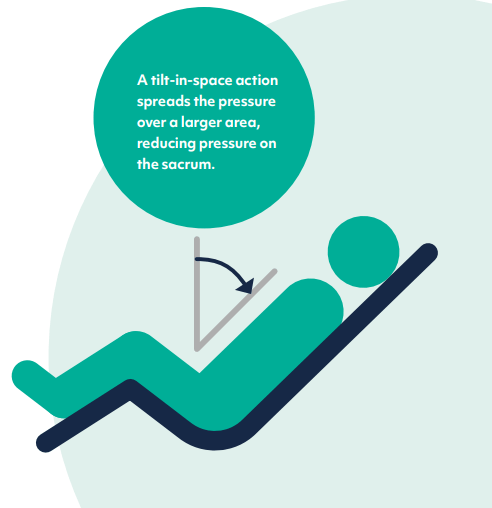
Tilt-in-space functionality
Adjustable Seat Sizing
The wrong seat dimensions can cause havoc with back pain as it forces people to adopt uncomfortable sitting positions. Measuring someone correctly for seat size is of paramount importance, and something our assessment team do on a daily basis.
A seat height that is too low causes raised knees, putting pressure on the sacral area and leading to sideways sitting and pelvic rotation. Conversely, a seat that is too high puts pressure through the feet as they are not supported, leading to swelling and poor circulation in the lower limbs.
Seat depth is another critical measurement; a seat depth that is too shallow will mean the thighs are not fully supported, whereas a seat that is too deep will put pressure on the back of the calves and force the patient to move forward in the chair and sit in a sacral position.
Since the launch of the Lento range, carers and staff can use the inbuilt adjustability to tailor the seat width, depth and height to each individual patient, without any special tools or training! We also have a range of riser recliners that can be made-to-measure. You can download our seat sizing form for free, or follow our guide on how to correctly measure someone for seat size.
Seat Rake
Increasing the seat rake, which is the angle or slope of the seat relative to the horizontal plane, helps the person rest back into the seat more and resume a more relaxed sitting posture, taking strain off the lower back.
Seating Adjustments to Support a Healthy Back
There are a number of postural adjustments built into our seating range that can help support people suffering from back problems.
Lateral Supports
Additional lateral wedges can be built into our Lento chairs to provide more support for those who tend to lean to one side. Padded lateral supports can be added to the chair to provide firmer sideways support for those with less upper body strength, and help counteract a scoliotic spine.
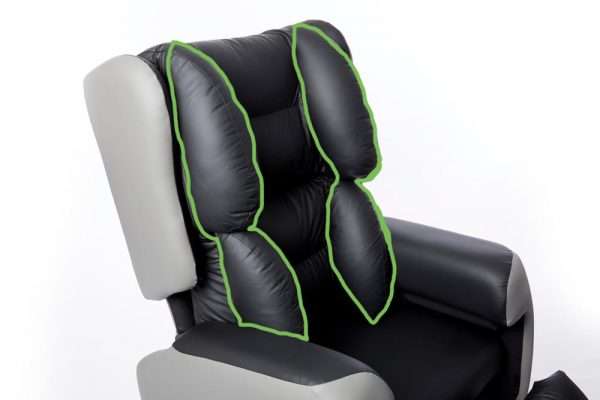
Lateral supports
Ergonomic Backrests
Choosing the right backrest style is a key ingredient in improving someone’s posture. Backrests are usually one of three main types; waterfall, lateral or cocoon-shaped.
Waterfall backrest
Waterfall cushions are stacked vertically, and can be repositioned to accommodate a kyphotic curve. The waterfall backrest comes as standard on our Lento Mobile chair, and is designed to reduce pressure on the lower back and promote good posture. The cushions can be easily repositioned with magnetic fastenings, and the amount of wadding adjusted through the zipped opening at the back, to suit the back profile of each individual.
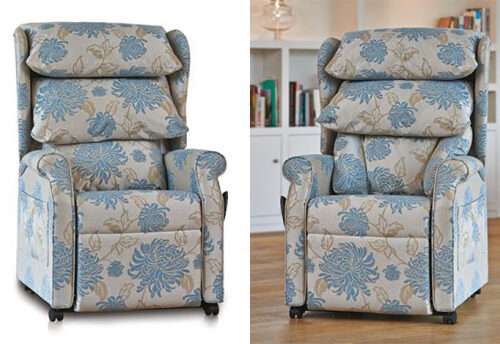
Waterfall backrests
Lateral backrest
Lateral backrests provide sideways support to help spinal alignment. These can be used in combination with waterfall cushions to provide good sideways support whilst accommodating a more curved or twisted spine, known as a ‘waterfall lateral’ back.
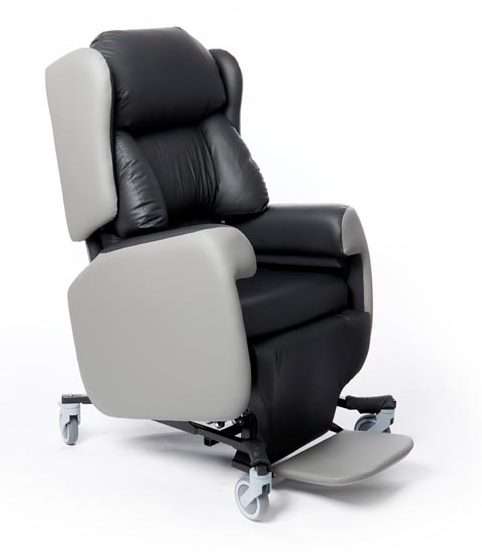
Lateral backrest
Cocoon backrest
The cocoon-shaped backrest unique to our Lento range gives a more all-round level of lateral support, from the trunk up to the head and neck. The cocoon shape cradles naturally around the person’s back, good for accommodating a slightly curved ‘C-shape’ spine.
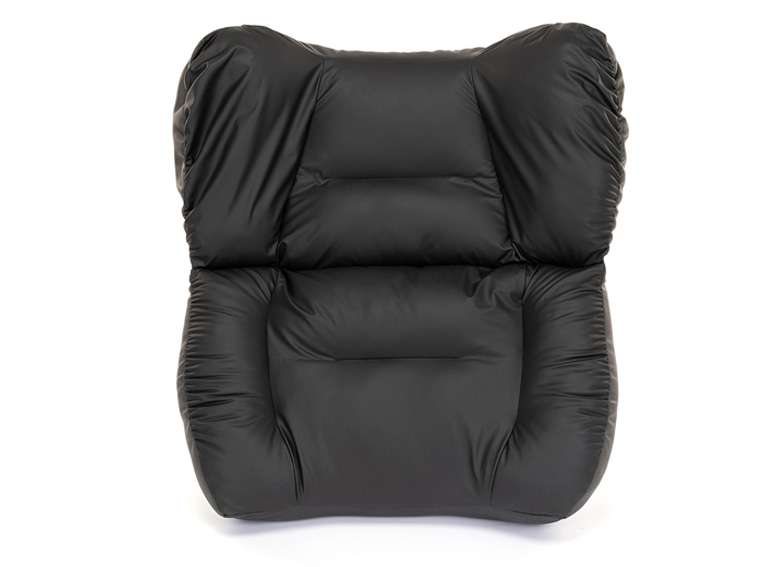
Cocoon backrest
Read more about different backrest styles in our guide to backrests for care chairs and rise recline chairs.
Head, Neck and Shoulder Support
Keeping the head cushioned and well supported avoids strain in the neck and upper back.
Horseshoe head support
The horseshoe head support is a great accessory to cushion the neck area, helping the user lean back into the chair. It rests on a weighted flap to is easy to reposition and take on and off the chair.
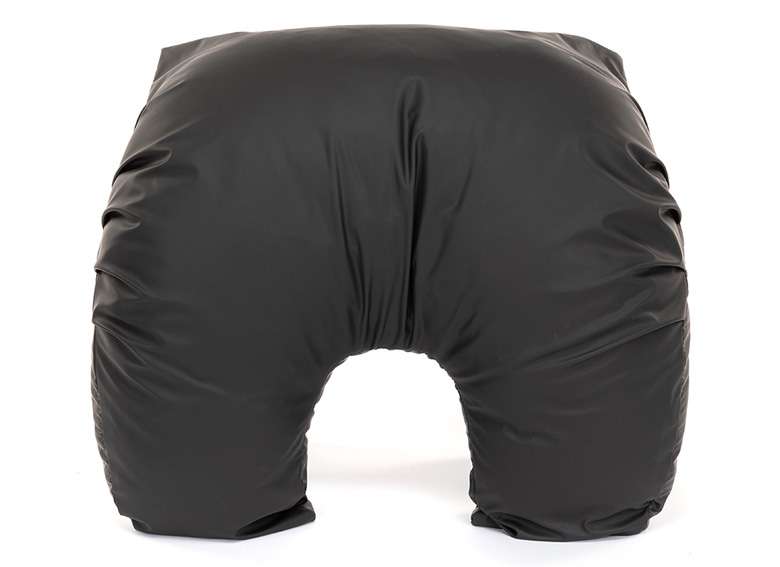
Horseshoe head support
Cradle head support
For people with weaker neck muscles, or paralysis that prevents them being able to support their own posture, the Cradle head support is a great solution to give all-round support, gently holding the head in position. It can be easily attached to the backrest of the chair and has multiple points of adjustment to position it correctly for each individual.
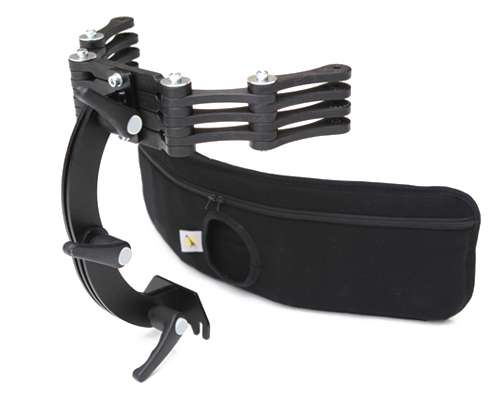
Cradle head support
Pommels
If someone has low muscle tone, as in the case of muscular dystrophy or advanced MND, a pommel is a very useful positioning tool. It is a raised section built into the seat, positioned between the person’s thighs, and should be made-to-measure for each client.
This is something our seating assessors can measure for in the assessment if there is a requirement. For people with poor muscle tone that struggle to maintain an upright posture, the pommel helps to hold them in the right position, preventing their sacral area from sliding forward and ensuring good pelvic positioning.
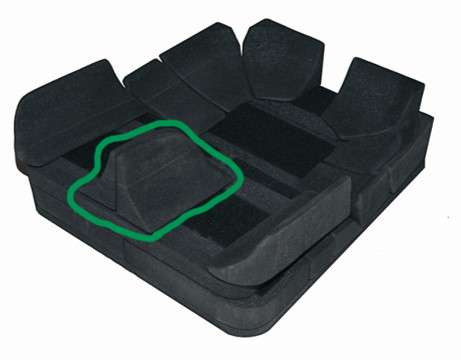
Seat pommel
Seating Recommendations: Ergonomic Chairs and Backrests
Lento Care Chair
The Lento Care Chair is ideal for people in community care settings that are seated for long periods at a time and need advanced levels of postural support. From head supports through to the adjustable footplate, the Lento Care Chair provides head-to-toe postural support, giving the client a blissful seating experience and promoting good midline positioning.
The inbuilt seat height, width and depth adjustment means that carers can tailor the seat sizing to each different patient to get the best pelvic positioning, which is fundamental to good seating ergonomics.
There are also lots of additional postural supports and accessories available, as mentioned throughout this article.
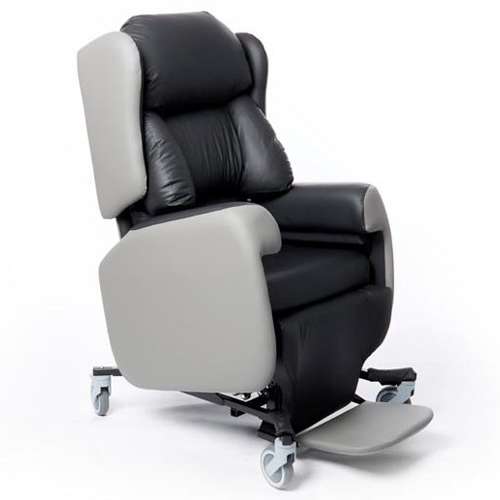
Lento Care Chair
Lento Mobile Riser Recliner
The Lento Mobile Riser Recliner has all the benefits of a riser recliner chair incorporated into a fully mobile patient chair, suitable for multi-user environments like hospitals.
It comes with waterfall cushions as standard, which are great for reducing pressure on the spine, and the cushions are attached magnetically allowing them to be repositioned to suit, or interchanged with different ones like the cocoon backrest.
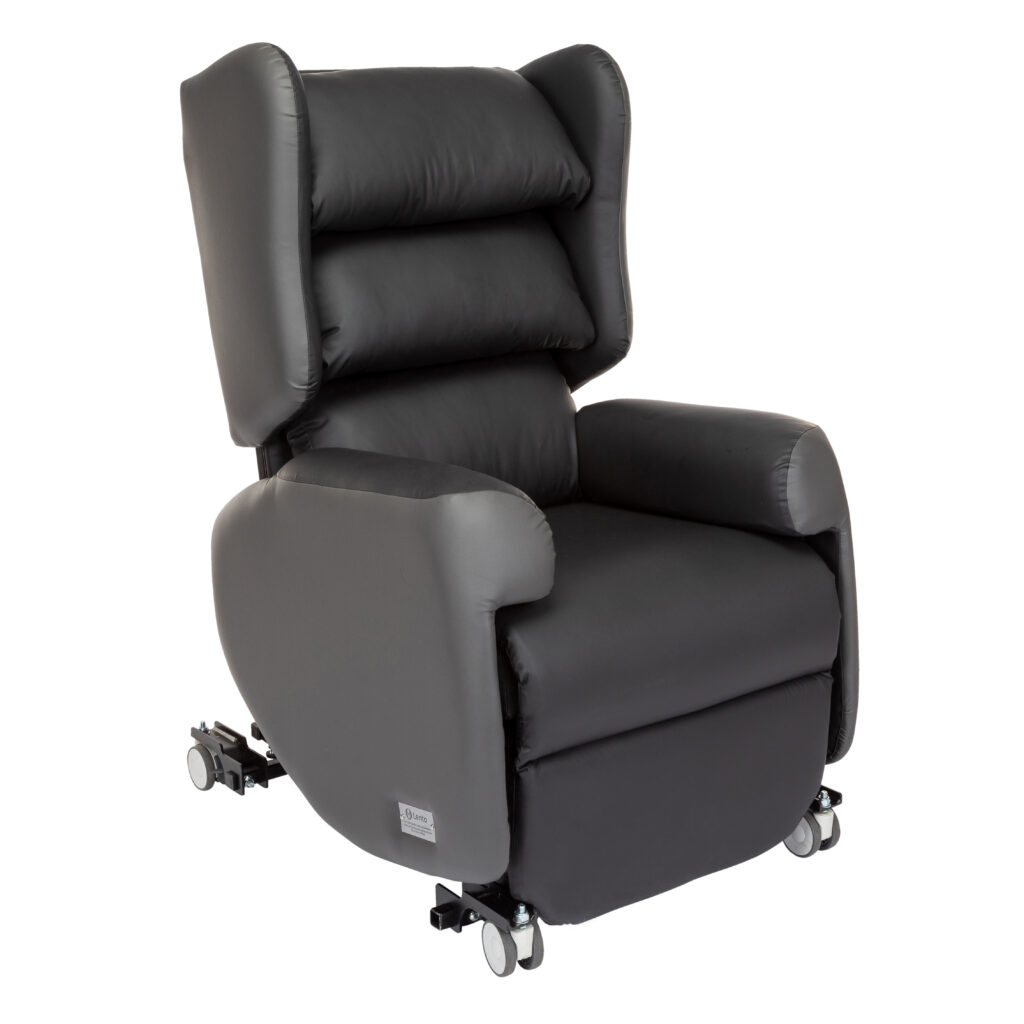
Lento Mobile riser recliner
Waterfall Lateral Backrest
The waterfall lateral backrest has the three waterfall cushions that come as standard with the Lento Mobile, with additional support cushions on each side of the trunk area, providing extra lateral support for people that tend to lean to one side.
VELA chair
The VELA Activity chair increases independence, helping people move around the home and workplace. Both the seat and backrest angle can be adjusted with hand levers, helping users adjust their posture to relieve back aches and strains. The chair has extra support in the lumbar region with the unique ALB backrest.
Ideal for people with arthritis, the VELA chairs help people save energy by wheeling themselves around their home or workplace, using the electric height adjustment to access different work surfaces.
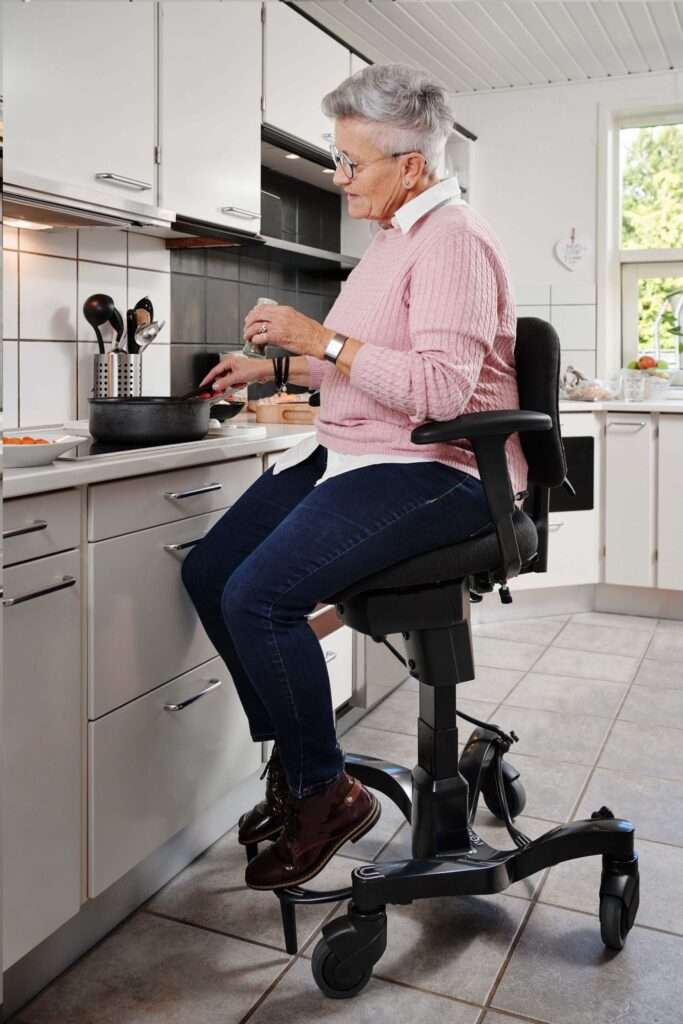
VELA activity chair
Conclusion
Whilst specialist seating cannot cure back pain, it can go a long way in reducing it as a result of improved posture and comfort.
It is crucial to get the right seat measurements as the basis for good pelvic positioning, then other features and accessories can be used to provide enhanced levels of comfort for the ultimate seating experience.
If you or a loved on are finding your current chair uncomfortable, why not reach out to our seating team today for a no-obligation assessment, to set you on the road to a better quality of life?
Free & No Obligation Assessment














